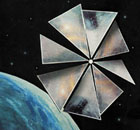The Planetary Society has struck two agreements with US government agencies to track its Cosmos 1 solar sail. Although ground stations near Moscow will provide the bulk of the tracking, the National Oceanic and Atmospheric Administration (NOAA) will also monitor the mission from its National Environmental Satellite Data Information Service site in Alaska. The US Air Force, meanwhile, will provide images of the deployed sail from the Air Force Maui Optical and Supercomputing site at Haleakala, Hawaii. Other tracking will be provided by the University of California’s Berkeley Space Science Laboratory ground station and a ground station in the Czech Republic.
 Funded by The Planetary Society and Cosmos Studios, the spacecraft was built in Russia by NPO Lavochkin and the Space Research Institute. Planetary Society executive director Louis Friedman has announced that all electronic systems aboard the spacecraft have been flight-qualified and the components have been shipped to the NPO Lavochkin facility for final integration into the frame of the vehicle. The completed craft may be sent to the launch preparation site near Murmansk as soon as the end of this year; it is to be launched from a Russian nuclear submarine aboard a Volna missile from the old Soviet nuclear arsenal. If successful, Cosmos 1 will become the first free-flying solar sail.
Funded by The Planetary Society and Cosmos Studios, the spacecraft was built in Russia by NPO Lavochkin and the Space Research Institute. Planetary Society executive director Louis Friedman has announced that all electronic systems aboard the spacecraft have been flight-qualified and the components have been shipped to the NPO Lavochkin facility for final integration into the frame of the vehicle. The completed craft may be sent to the launch preparation site near Murmansk as soon as the end of this year; it is to be launched from a Russian nuclear submarine aboard a Volna missile from the old Soviet nuclear arsenal. If successful, Cosmos 1 will become the first free-flying solar sail.
Centauri Dreams‘ take: Cosmos 1 is an educational event, meant as an outreach to the public on behalf of the concept of solar sailing. If successful, it will raise awareness of the technology and perhaps spark further commercial work. It is not an attempt to develop solar sails to the point where serious science missions can be flown, although some science (such as James Benford’s microwave experiment, which will use the Goldstone dish to attempt to demonstrate beamed propulsion) will take place on the mission.
But when I talked to NASA solar sail expert Sandy Montgomery at Marshall Space Flight Center last year about what comes next, he pointed to the hard engineering work to follow. “I appreciate what [the Cosmos 1 team] is doing and am looking forward to it with great interest. But we need to continue with a solid NASA engineering approach to answer the questions for materials that will survive for long periods in space, using mechanisms that are well understood. Ultimately,” Montgomery added, “we need to retire a lot of the risk so that a scientist who has to choose between a known chemical mission of a short duration and a sail mission of a longer duration won’t find any great amount of risk in that sail and therefore choose not to use it.”

